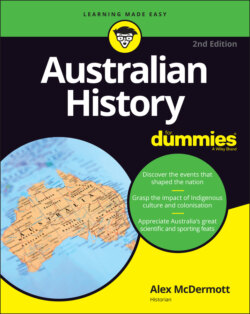Читать книгу Australian History For Dummies - Alex McDermott - Страница 39
Macassan fishermen
ОглавлениеMacassar was a port on the island of Sulawesi, part of what is today Indonesia, and the centre of a thriving trade in sea cucumbers (also known as trepang, or beche-de-mer). These were considered a pretty wild delicacy in China as an aphrodisiac — think an early version of modern-day Viagra (or perhaps don’t) — and they were plentiful in the shallow seas along the coast of northern Australia between Arnhem Land in the Northern Territory and the Kimberleys in Western Australia.
Because plenty of profit could be had from feeding heavy Chinese demand, every year from at least the 1720s on (but probably earlier) Macassan fishermen would sail their boats with the monsoon winds down to Australia. Here they’d stay for about half a year, catching, gutting, boiling, drying and smoking trepang before sailing back to Macassar with a full cargo.
The Macassans camped onshore each summer, and built big fireplaces for large iron pots and cauldrons to boil the trepang. Afterwards, the trepang would be buried in sand to help them dry. (If you’ve ever been in Australia’s top end during the sultry monsoonal summer months, you’ll understand why they had to be buried to get properly dried!). They’d then be smoked in bamboo sheds the Macassans had built for the purpose.
Throughout their visits to Australia, Macassans interacted constantly with the local Aboriginals, who began to paint distinctive Macassan images — of the boats or of steel knives — in their rock art. Relations weren’t always rosy — outbursts of violence and retaliation occurred periodically — but, for the most part, the interactions were punctuated by exchange. Tobacco, pipes, the new technique of dugout canoe-making, new words, steel knives and axes were all things Indigenous Australian tribes acquired from the Macassans (as well as smallpox, unfortunately). In turn, Macassans were given access to the trepang resource, and were allowed to take some Aboriginal women as wives.
